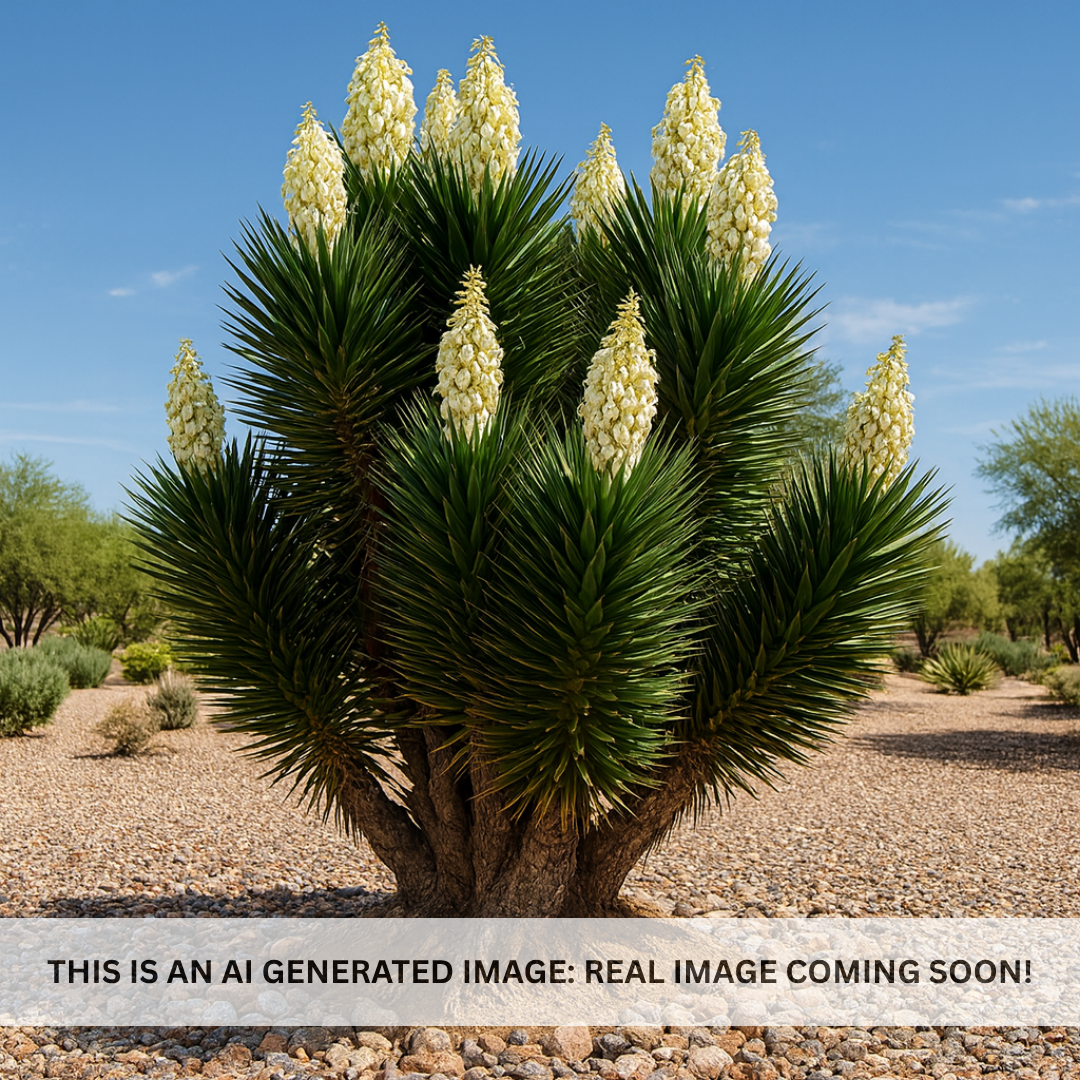My Store
Spanish Bayonet
Spanish Bayonet
Couldn't load pickup availability
Plant Type: perennial, evergreen succulent shrub (tree-form yucca)**
Plant Height: 6–15 feet (can reach up to 20 feet in maturity)**
Spread: 3–6 feet
Flower Color: creamy white (fragrant clusters)
Sun Exposure: Full sun
Spanish Bayonet / Yucca aloifolia: A Bold, Architectural Yucca with Dramatic Spikes and Sculptural Form
Yucca aloifolia, commonly known as the Spanish Bayonet, is a striking, upright yucca species native to the southeastern U.S. and coastal Mexico. With its rigid, sword-like leaves, sculptural silhouette, and massive clusters of creamy white flowers, it brings an unmistakable architectural presence to Arizona landscapes.
Despite its fierce appearance, the Spanish Bayonet is a durable, low-maintenance plant perfectly suited for desert climates—offering both form and resilience. Whether used as a focal point, screen, or textural accent, it commands attention and delivers lasting structure to any xeric garden.
Key Features of Yucca aloifolia
The Spanish Bayonet grows as a single or multi-trunked shrub or small tree, featuring stiff, sword-shaped leaves that radiate symmetrically from the trunk. The leaves are dark green to blue-green, up to 2–2.5 feet long, and terminate in a sharp spine, giving the plant its “bayonet” name.
In late spring through early summer, mature plants produce tall flower spikes (up to 2 feet long) densely packed with bell-shaped creamy white blooms. The flowers are fragrant, showy, and attract pollinators like moths and bees.
Over time, the plant forms a tall, dramatic silhouette—often branching after flowering—and develops a rough, textured trunk as lower leaves age and fall away. It’s a bold, vertical accent that brings height and visual movement to desert compositions.
Growing and Care Tips
Yucca aloifolia thrives in full sun and well-draining, sandy or rocky soil. In the Phoenix Valley, it performs beautifully in both direct desert exposure and reflected heat, and once established, it’s among the most drought-tolerant yuccas available.
Water deeply but infrequently during establishment—every 14–21 days depending on soil and temperature. Once mature, the Spanish Bayonet needs minimal irrigation—only every 4–6 weeks during summer droughts and rarely in winter. Overwatering can lead to root rot, especially in clay soils.
It is cold hardy to about 10°F and tolerates brief frosts. Growth is moderate to slow, with each trunk gradually elongating and occasionally branching after bloom.
Minimal maintenance is required. Remove spent flower stalks and lower leaves as desired for a clean appearance. Always handle with care or heavy gloves—the sharp leaf tips can puncture skin easily.
Landscaping Uses
The Spanish Bayonet is ideal for architectural, desert, and coastal landscapes where bold form and minimal care are priorities. It serves beautifully as a focal point, vertical accent, or natural screen, adding strong lines and texture contrast against softer succulents or gravel.
Pair it with Blue Glow Agave, Golden Barrel Cactus, or Desert Spoon (Dasylirion wheeleri) for balanced height and visual harmony. It’s also effective as a barrier planting along property lines or walls, as its dense foliage and sharp leaves naturally discourage foot traffic.
In modern landscapes, use it as a living sculpture near entryways or patios—its upright symmetry and clean geometry complement contemporary architectural styles perfectly. Under landscape lighting, the linear leaves cast dramatic, radial shadows that highlight its structural beauty at night.
Summary
The Spanish Bayonet (Yucca aloifolia) is a bold, timeless yucca that symbolizes both beauty and toughness. With its upright form, striking leaves, and showy blooms, it delivers drama and texture to Arizona landscapes while requiring almost no maintenance. Perfect for designers seeking strong architectural structure, it’s a living statement piece—enduring, elegant, and distinctly desert.
Three Timbers Installation Guide (Feel Free to Follow):
Yucca aloifolia Planting Guide:
Location: Full sun; choose an open, exposed site with at least 8 hours of direct light daily. Handles reflected heat and coastal wind equally well.
Soil: Use a sharply draining blend of cactus mix, decomposed granite, and coarse sand. Avoid compacted or clay-heavy soils.
Spacing: Allow 4–6 feet between plants or nearby structures to accommodate mature spread and airflow.
Planting Depth: Keep the root crown level with or slightly above soil grade. Do not bury the base of the trunk.
Support: None required; the plant is naturally self-supporting.
Watering Guide:
Watering After Planting: Water deeply once after installation to settle soil. Then allow it to dry completely before watering again. During the first 3–4 months, water every 14–21 days depending on heat and soil drainage.
When is the Plant Established? The Spanish Bayonet is considered established after 6–9 months, once new top growth appears and color deepens to a rich green.
Watering Once Established: Water every 4–6 weeks in summer if no rainfall occurs. In winter, watering is rarely necessary.
Drip Irrigation Setup: Install one low-flow emitter (1–2 gallons per hour) about 12–18 inches from the base, angled outward. Run sparingly and allow full drying between cycles.
General Watering Tips: Always confirm soil dryness before watering. Overwatering can lead to softening at the crown or trunk rot. A top dressing of decomposed granite or gravel enhances appearance, improves drainage, and emphasizes the plant’s bold, upright silhouette. Keep gravel several inches away from the base for airflow and long-term health.
Share












